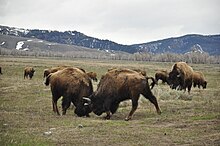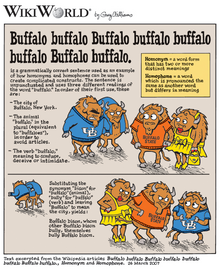This is an old revision of this page, as edited by Quiddity (talk | contribs) at 19:11, 9 August 2013 (Reverted to revision 565933725 by DoctorKubla: rv original research. (TW)). The present address (URL) is a permanent link to this revision, which may differ significantly from the current revision.
Revision as of 19:11, 9 August 2013 by Quiddity (talk | contribs) (Reverted to revision 565933725 by DoctorKubla: rv original research. (TW))(diff) ← Previous revision | Latest revision (diff) | Newer revision → (diff)
PN = proper noun
N = noun
V = verb
NP = noun phrase
RC = relative clause
VP = verb phrase
S = sentence
"Buffalo buffalo Buffalo buffalo buffalo buffalo Buffalo buffalo" is a grammatically correct sentence in American English, used as an example of how homonyms and homophones can be used to create complicated linguistic constructs. It has been discussed in literature since 1972 when the sentence was used by William J. Rapaport, an associate professor at the University at Buffalo. It was posted to Linguist List by Rapaport in 1992. It was also featured in Steven Pinker's 1994 book The Language Instinct as an example of a sentence that is "seemingly nonsensical" but grammatical. Pinker names his student Annie Senghas as the inventor of the sentence.
The sentence's meaning becomes clearer when it's understood that it uses the city of Buffalo, New York, and the somewhat-uncommon verb "to buffalo" (meaning "to bully or intimidate"), and when the punctuation and grammar is expanded so that the sentence reads as follows: "Buffalo buffalo that Buffalo buffalo buffalo, buffalo Buffalo buffalo." The meaning becomes even clearer when synonyms are used: "Buffalo bison that other Buffalo bison bully, themselves bully Buffalo bison."
Sentence construction



The sentence is unpunctuated and uses three different readings of the word "buffalo". In order of their first use, these are
- a. the city of Buffalo, New York, United States, which is used as a noun adjunct in the sentence and is followed by the animal;
- n. the noun buffalo, an animal, in the plural (equivalent to "buffaloes" or "buffalos"), in order to avoid articles;
- v. the verb "buffalo" meaning to bully, confuse, deceive, or intimidate.
Marking each "buffalo" with its use as shown above gives:
- Buffalo buffalo Buffalo buffalo buffalo buffalo Buffalo buffalo.
The sentence uses a restrictive clause, so there are no commas, nor is there the word "which," as in, "Buffalo buffalo, which Buffalo buffalo buffalo, buffalo Buffalo buffalo." This clause is also a reduced relative clause, so the word that, which could appear between the second and third words of the sentence, is omitted.
Thus, the parsed sentence reads as a claim that bison who are intimidated or bullied by bison are themselves intimidating or bullying bison (at least in the city of Buffalo– implicitly, Buffalo, NY):
- Buffalo buffalo (buffalo from Buffalo NY) Buffalo buffalo buffalo (that the buffalo from Buffalo NY bully) buffalo Buffalo buffalo (are bullying buffalo from Buffalo NY)
- buffalo(es) from Buffalo buffalo(es) from Buffalo intimidate buffalo(es) from Buffalo.
- Bison from Buffalo, New York, who are intimidated by other bison in their community, also happen to intimidate other bison in their community.
- The buffalo from Buffalo who are buffaloed by buffalo from Buffalo, buffalo (verb) other buffalo from Buffalo.
- Buffalo buffalo (main clause subject) Buffalo buffalo (subordinate clause subject) buffalo (subordinate clause verb) buffalo (main clause verb) Buffalo buffalo (main clause direct object).
The sentence can be clarified by substituting the synonym "bison" for the animal "buffalo", "bully" for the verb "buffalo", and "New York" to refer to the state of the city Buffalo:
- "New York bison New York bison bully bully New York bison", or:
- "New York bison whom other New York bison bully, themselves bully New York bison".
Or, alternatively with the city name intact:
- "Buffalo bison Buffalo bison bully bully Buffalo bison".
Removing the classifier noun "Buffalo" (the city) further clarifies the sentence (note that the initial capital is retained as the common noun "buffalo" now starts the sentence):
- "Buffalo buffalo buffalo buffalo buffalo."
- "Bison bison bully bully bison."
Usage
Thomas Tymoczko has pointed out that there is nothing special about eight "buffalos"; any sentence consisting solely of the word "buffalo" repeated any number of times is grammatically correct. The shortest is "Buffalo!", which can be taken as an imperative instruction to bully someone (" buffalo!") with the implied subject "you" removed. Tymoczko uses the sentence as an example illustrating rewrite rules in linguistics.
Other words using the same pattern
Other English words can be used to make grammatical (but not necessarily meaningful) sentences of this form, containing endless consecutive repetitions. Any word that is both a plural noun and an uninflected transitive verb will work; for example, police or dice. Adding a place name like Police, Poland, can allow for a sentence identical in structure to the Buffalo example, though not necessarily with uniform pronunciation: "Police police Police police police police Police police."
A somewhat similar non-punctuated example is "James while John had had had had had had had had had had had a better effect on the teacher". This could concern a situation in an English class regarding the usage of the word had, and might be punctuated as, "James, while John had had 'had', had had 'had had'; 'had had' had had a better effect on the teacher."
The sentence in popular culture
An expanded form of the sentence is a lyric in the Alt-J song "Buffalo" from the soundtrack of Silver Linings Playbook.
See also
- Colorless green ideas sleep furiously
- Eats, Shoots & Leaves
- Lion-Eating Poet in the Stone Den
- List of linguistic example sentences
- Recursion
- Semantic satiation
References
- Rapaport, William J. 22 September 2006. "A History of the Sentence "Buffalo buffalo buffalo Buffalo buffalo."". Accessed 23 September 2006. (archived copy)
- Rapaport, William J. 19 February 1992. "Message 1: Re: 3.154 Parsing Challenges". Accessed 14 September 2006.
- Pinker, Steven. The Language Instinct: How the Mind Creates Language, William Morrow and Company, Inc., New York, 1994. p. 210
- Thomas Tymoczko; James M. Henle (2000). Sweet reason: a field guide to modern logic (2 ed.). Birkhäuser. pp. 99–100, 104. ISBN 978-0-387-98930-3.
- Thomas Tymoczko; James M. Henle (2000). Sweet reason: a field guide to modern logic (2 ed.). Birkhäuser. pp. 104–105. ISBN 978-0-387-98930-3.
External links
Listen to this article(2 parts, 5 minutes)
- "Buffaloing buffalo" at Language Log, 20 January 2005
- Easdown, David. Template:PDF
Video clip
Categories: